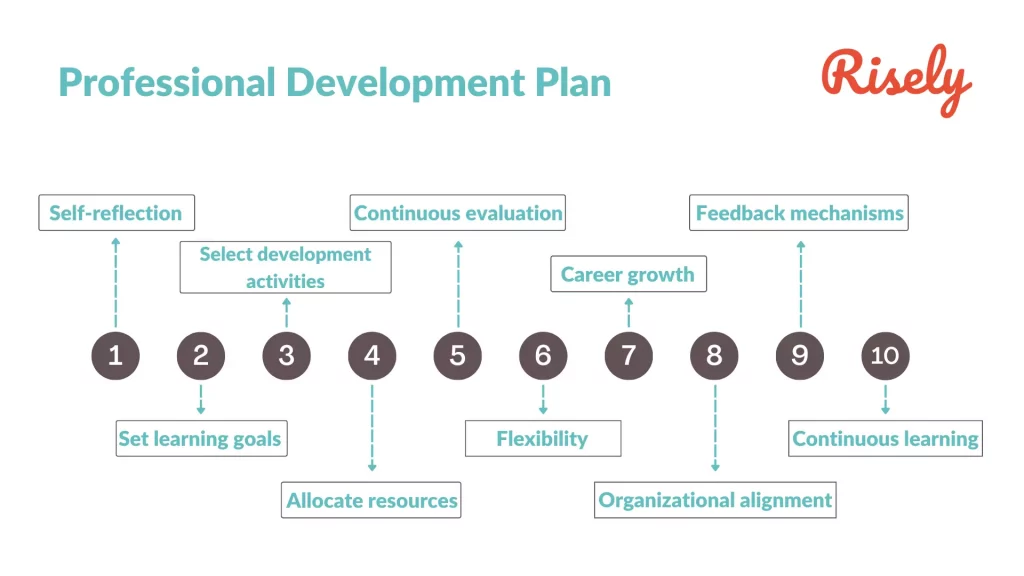What is a Professional Development Budget? Effective Ways to Overcome 7 Common Challenges
Are you looking to take your professional growth to the next level? Do you want to invest in your skills, knowledge, and career advancement? A well-planned professional development budget is your key to unlocking opportunities. In today’s dynamic and competitive work environment, continuous learning and development have become essential for staying ahead. But how do you optimize your professional development budget to maximize your investments? In this blog, we will explore the strategies, considerations, and solutions for maximizing your professional development budget. From identifying challenges and overcoming obstacles to aligning with organizational goals and prioritizing development areas, we’ll provide you with actionable insights to ensure your professional development budget is utilized effectively. Let’s dive in!Understanding Professional Development
Professional development refers to the ongoing process of acquiring and improving skills, knowledge, and competencies relevant to one’s profession or career. It involves training programs, workshops, conferences, certifications, and continuous learning initiatives. Professional development aims to enhance job performance, expand capabilities, and stay up-to-date with industry trends and advancements. It is crucial for personal growth, career advancement, and organizational success. By investing in professional development, individuals can improve their skills, gain new insights, and adapt to evolving work environments. It is a proactive approach to staying competitive, achieving career goals, and unlocking new opportunities for professional growth.Creating an Effective Professional Development Plan

- Self-reflection: Assess current skills and knowledge gaps.
- Set learning goals: Establish specific objectives aligned with career aspirations.
- Select development activities: Choose suitable learning opportunities such as courses or mentoring.
- Allocate resources: Set a timeline and designate resources for effective implementation.
- Continuous evaluation: Regularly assess progress and adjust the plan as needed.
- Flexibility: Allow for adaptation to changing circumstances and emerging opportunities.
- Career growth: Drive personal and professional development to advance in one’s field.
- Organizational alignment: Ensure development goals align with the needs of the organization.
- Feedback mechanisms: Incorporate feedback to enhance the effectiveness of the plan.
- Continuous learning: Embrace a lifelong learning mindset for ongoing professional growth.
What is Professional Development Budget?
A professional development budget refers to a specific allocation of financial resources set aside by an individual or an organization to support employees’ learning and development needs. It is a designated amount of money dedicated to investing in activities and programs that enhance individuals’ skills, knowledge, and capabilities within a professional context. A professional development budget aims to provide employees with opportunities to grow, learn new skills, stay current in their field, and advance their careers. It can fund various initiatives such as training programs, workshops, conferences, certifications, coaching, mentoring, and educational courses. Having a professional development budget demonstrates a commitment to employee development, promotes a culture of continuous learning, and helps organizations attract and retain talented individuals by offering opportunities for growth and advancement.Key Considerations in Optimizing Professional Development Budget
Asses Organizational Needs- Conduct a thorough assessment to identify employees and the organization’s specific learning and development needs.
- Gather employee, manager, and stakeholder feedback to ensure alignment with their skill gaps and career aspirations.
- Ensure that the allocated budget aligns with the strategic objectives and priorities of the organization.
- Focus on professional development initiatives that directly contribute to organizational growth, performance, and innovation.
- Determine which learning initiatives are most critical and align them with the overall goals and needs of the organization.
- Consider each development opportunity’s urgency and potential impact to allocate the budget effectively.
- Evaluate the potential impact and value of each learning opportunity to maximize the ROI of the professional development budget.
- Consider the long-term benefits and measurable outcomes that align with the organization’s goals.
- Explore a range of learning methods and platforms, such as online courses, workshops, conferences, mentorship programs, and internal training sessions.
- Optimize the budget by leveraging cost-effective solutions like e-learning platforms and open educational resources.
- Regularly assess the effectiveness and impact of professional development initiatives to make data-driven decisions for future budget allocation.
- Seek participant feedback and track key performance indicators to ensure the budget is used efficiently.
- Involve employees in decision-making by providing opportunities to contribute ideas and preferences for professional development.
- Foster a learning culture and encourage employees to take ownership of their growth and development.
- Explore partnerships with external training providers, educational institutions, or industry associations to access additional resources and cost-saving opportunities.
- Leverage collaborations to enhance the quality and diversity of professional development programs within the allocated budget.

Overcoming Common Challenges in Professional Development Budgeting
Limited Budget Allocation Solution Maximize cost-effective options such as online courses, webinars, and virtual conferences. Leverage free or low-cost resources like open educational materials. Prioritize development areas with the highest impact and explore alternative funding sources or partnerships. Lack of Alignment with Organizational Goals Ensure that professional development initiatives are directly tied to the organization’s strategic objectives. Align employee development plans with the skills needed to achieve those goals. Regularly communicate the connection between professional development and organizational success to gain support for budget allocation. Unclear Return on Investment (ROI) Establish metrics and evaluation methods to measure the impact of professional development activities. Gather participant feedback and track outcomes such as improved performance, increased employee engagement, and career advancement. Communicate the ROI to stakeholders to demonstrate the value of the budget allocation. Identifying Relevant and High-Quality Development Opportunities Conduct thorough research on available programs, workshops, and certifications. Seek recommendations from industry associations or trusted sources. Consider feedback from previous participants and review the reputation and credibility of providers. Create a vetting process to ensure the chosen opportunities align with desired learning outcomes. Lack of Employee Engagement Involve employees in the professional development planning process. Seek their input on learning needs and preferences. Encourage employees to take ownership of their development by providing resources for self-directed learning and setting individual goals. Foster a culture of continuous learning and create opportunities for knowledge sharing and peer-to-peer support. Difficulty in Prioritizing Development Areas Conduct a thorough needs assessment to identify critical skill gaps and development priorities. Prioritize based on alignment with organizational goals, urgency, and potential impact. Involve key stakeholders in decision-making to gain diverse perspectives and ensure buy-in for the chosen priorities. Lack of Time for Development Activities Provide flexibility in scheduling to accommodate employee development activities. Explore options for micro-learning, bite-sized modules, or blended learning approaches that allow employees to learn at their own pace. Incorporate learning into regular work routines and encourage managers to support and prioritize employee development. By addressing these challenges and implementing the suggested solutions, organizations can overcome obstacles in professional development budgeting and create effective strategies for employee growth and organizational success.Conclusion
Optimizing and effectively managing a professional development budget is crucial for organizations and individuals. Organizations can maximize the impact of their professional development investments by strategically allocating resources, aligning initiatives with organizational goals, and leveraging cost-effective options. Encouraging a culture of continuous learning, involving employees in the planning process, and measuring the return on investment further enhance the effectiveness of the budget. Overcoming common challenges such as limited budgets, lack of alignment, and identifying relevant opportunities requires thoughtful planning and adaptability. With a well-planned and executed professional development budget, organizations can foster employee growth, enhance skills, and drive long-term success in a rapidly evolving professional landscape.Focus on active listening to spot gender inequality and bias in your team.
Take the free active listening skill assessment to identify weak areas and get support.
FAQs
What is the personal development budget?
The training budget typically includes costs associated with designing, developing, and delivering training programs, such as instructor fees, materials, technology and software expenses, venue rentals, travel, and administrative overheads.
What is included in the training budget?
A personal development budget is a set amount of money an individual or organization allocates to invest in activities, resources, courses, or experiences that contribute to the individual’s personal and professional growth and development.
What is the value of professional development plan?
A professional development plan provides a structured roadmap for individuals to enhance their skills, knowledge, and abilities. It increases job satisfaction, improves performance, promotes career advancement, and ensures individuals stay competitive and adaptable.
How do you define professional development?
Professional development refers to the intentional and continuous process of acquiring and refining knowledge, skills, and competencies relevant to one’s profession. It encompasses training, workshops, conferences, networking, and self-directed learning to enhance professional growth and performance.
Other Related Blogs
How to Create a Course with AI: A Guide for L&D Professionals
How to Create a Course with AI: A Guide for L&D Professionals According to a McKinsey survey(1), only 11% of business leaders believe their leadership development initiatives yield meaningful results.…
How to build a Learning and Development Action Plan ft Katie Greenwood
Does your company’s Learning and Development (L&D) strategy feel like more “guessing” than “winning”? You’re not the only one! In today’s fast-changing world, taking a random approach to L&D is…
Generative AI for Learning and Development: Getting Started
Generative AI for Learning and Development: Getting Started In 2024, organizations spent $401 billion globally on corporate training(1), yet 70% of employees report feeling unprepared for the future of work…
Future proofing a learning strategy for organizations with Inna Horvath
Future Proofing a Learning Strategy for Organizations with Inna Horvath With the advent of AI, everyone’s anticipating changes. L&D leaders in charge of building a learning strategy for organizations are…


